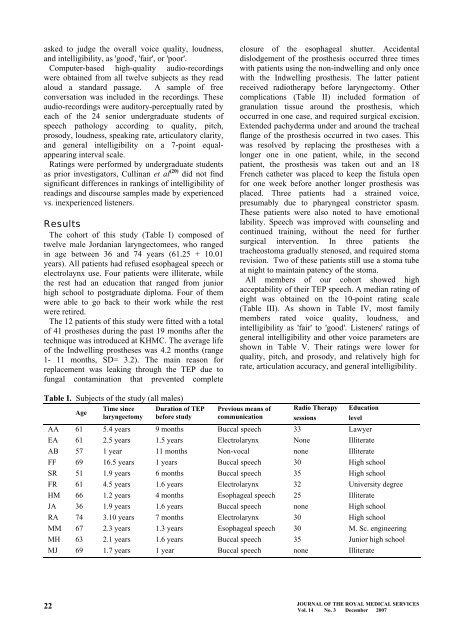A. Attieh, A. Wreikat, N. Arda, M. Hiari, A. Ayoub, G. Woodson, D ...
A. Attieh, A. Wreikat, N. Arda, M. Hiari, A. Ayoub, G. Woodson, D ...
A. Attieh, A. Wreikat, N. Arda, M. Hiari, A. Ayoub, G. Woodson, D ...
You also want an ePaper? Increase the reach of your titles
YUMPU automatically turns print PDFs into web optimized ePapers that Google loves.
asked to judge the overall voice quality, loudness,<br />
and intelligibility, as 'good', 'fair', or 'poor'.<br />
Computer-based high-quality audio-recordings<br />
were obtained from all twelve subjects as they read<br />
aloud a standard passage. A sample of free<br />
conversation was included in the recordings. These<br />
audio-recordings were auditory-perceptually rated by<br />
each of the 24 senior undergraduate students of<br />
speech pathology according to quality, pitch,<br />
prosody, loudness, speaking rate, articulatory clarity,<br />
and general intelligibility on a 7-point equalappearing<br />
interval scale.<br />
Ratings were performed by undergraduate students<br />
as prior investigators, Cullinan et al (20) did not find<br />
significant differences in rankings of intelligibility of<br />
readings and discourse samples made by experienced<br />
vs. inexperienced listeners.<br />
Results<br />
The cohort of this study (Table I) composed of<br />
twelve male Jordanian laryngectomees, who ranged<br />
in age between 36 and 74 years (61.25 + 10.01<br />
years). All patients had refused esophageal speech or<br />
electrolaynx use. Four patients were illiterate, while<br />
the rest had an education that ranged from junior<br />
high school to postgraduate diploma. Four of them<br />
were able to go back to their work while the rest<br />
were retired.<br />
The 12 patients of this study were fitted with a total<br />
of 41 prostheses during the past 19 months after the<br />
technique was introduced at KHMC. The average life<br />
of the Indwelling prostheses was 4.2 months (range<br />
1- 11 months, SD= 3.2). The main reason for<br />
replacement was leaking through the TEP due to<br />
fungal contamination that prevented complete<br />
closure of the esophageal shutter. Accidental<br />
dislodgement of the prosthesis occurred three times<br />
with patients using the non-indwelling and only once<br />
with the Indwelling prosthesis. The latter patient<br />
received radiotherapy before laryngectomy. Other<br />
complications (Table II) included formation of<br />
granulation tissue around the prosthesis, which<br />
occurred in one case, and required surgical excision.<br />
Extended pachyderma under and around the tracheal<br />
flange of the prosthesis occurred in two cases. This<br />
was resolved by replacing the prostheses with a<br />
longer one in one patient, while, in the second<br />
patient, the prosthesis was taken out and an 18<br />
French catheter was placed to keep the fistula open<br />
for one week before another longer prosthesis was<br />
placed. Three patients had a strained voice,<br />
presumably due to pharyngeal constrictor spasm.<br />
These patients were also noted to have emotional<br />
lability. Speech was improved with counseling and<br />
continued training, without the need for further<br />
surgical intervention. In three patients the<br />
tracheostoma gradually stenosed, and required stoma<br />
revision. Two of these patients still use a stoma tube<br />
at night to maintain patency of the stoma.<br />
All members of our cohort showed high<br />
acceptability of their TEP speech. A median rating of<br />
eight was obtained on the 10-point rating scale<br />
(Table III). As shown in Table IV, most family<br />
members rated voice quality, loudness, and<br />
intelligibility as 'fair' to 'good'. Listeners' ratings of<br />
general intelligibility and other voice parameters are<br />
shown in Table V. Their ratings were lower for<br />
quality, pitch, and prosody, and relatively high for<br />
rate, articulation accuracy, and general intelligibility.<br />
Table I. Subjects of the study (all males)<br />
Age<br />
Time since<br />
laryngectomy<br />
Duration of TEP<br />
before study<br />
Previous means of<br />
communication<br />
Radio Therapy<br />
sessions<br />
Education<br />
level<br />
AA 61 5.4 years 9 months Buccal speech 33 Lawyer<br />
EA 61 2.5 years 1.5 years Electrolarynx None Illiterate<br />
AB 57 1 year 11 months Non-vocal none Illiterate<br />
FF 69 16.5 years 1 years Buccal speech 30 High school<br />
SR 51 1.9 years 6 months Buccal speech 35 High school<br />
FR 61 4.5 years 1.6 years Electrolarynx 32 University degree<br />
HM 66 1.2 years 4 months Esophageal speech 25 Illiterate<br />
JA 36 1.9 years 1.6 years Buccal speech none High school<br />
RA 74 3.10 years 7 months Electrolarynx 30 High school<br />
MM 67 2.3 years 1.3 years Esophageal speech 30 M. Sc. engineering<br />
MH 63 2.1 years 1.6 years Buccal speech 35 Junior high school<br />
MJ 69 1.7 years 1 year Buccal speech none Illiterate<br />
22<br />
JOURNAL OF THE ROYAL MEDICAL SERVICES<br />
Vol. 14 No. 3 December 2007
















